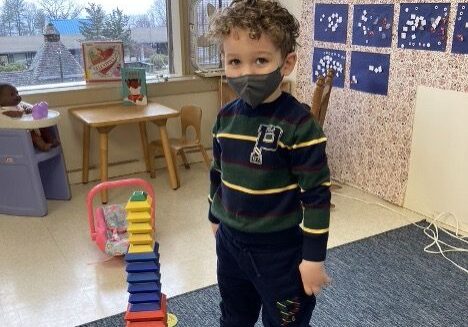Building Number Sense
May 4, 2022

Preschool
As Preschoolers get ready to eat snack, they take a moment to clap 4, 7, or 11 times. In line, the teacher taps each child’s head and the class counts in unison. This work prepares them to successfully count with one-to-one correspondence as they approach Junior Kindergarten. They explore patterns and sorting and begin to make connections between printed numbers and groups of objects and people. Students use multi-colored teddy bear counters to sort by color and size and begin to build AB patterns.
After reading several versions of Goldilocks and the Three Bears, students decide which version is their favorite. They might place their name on a teddy bear and place their “vote” above a picture of their favorite version. The class then counts, using one-to-one correspondence, the number of bears above each version and teachers model mathematical language to describe which story had the most votes and which had the least.
Extensions for home:
- Create a pattern and have the child guess what comes next or look for patterns around them.
- Make a graph together about anything-favorite breakfast choice, favorite bedtime story, or favorite snack food. Discuss what you found out!
Junior Kindergarten
At Morning Meeting a student is in charge of tapping and counting each child present to utilize their one-to-one correspondence. A teacher then asks, “If we have 11 students in the class, is anyone missing?” They discuss the responses to the question of the day, which might be, “Do you like raisins or graham crackers better?” Students count and compare the responses in each column and offer their individual ideas. During choice time, students who are especially excited about numbers might build with Unifix cubes along the floor until they get to 55, 72, or 100!
All students will begin looking at the straights and curves that make up printed numbers by using wooden blocks to form them before beginning to practice them with paper and pencil on their own. Dramatic play offers opportunities for typewriters, cash registers, and ordering pads to use and practice numbers in meaningful ways. Lastly, students begin to discuss what an estimate is and how they can use the information available to them to make a guess about how many items they think there are in total.
Extensions for home:
- Practice counting-on from 10 using different objects. The goal is for your child to identify 10 items and count additional objects starting with the number 11 instead of starting back to the first one.
- Stress accuracy, not speed, when practicing counting with one-to-one correspondence: Say the number, touch the object, then move on!
- Play games that practice counting and identifying more than and less than. Turn taking is a bonus skill!
Kindergarten
As part of their morning work, Kindergarteners create physical 3D bar graphs as they respond to a question of the day. They might be asked to indicate their preferred theme with a personalized wooden block, which they drop into a slot in a graphing box. This box was designed to reduce peer influence when making a choice. Later, at Morning Meeting, a teacher places the blocks one category at a time on top of the graphing box so the students can have an authentic opportunity to practice using the language of more than, less than, and equal and comment on what they notice about each graph.
Morning work includes counting chain links to represent the number of days students have been in school by ones, fives, and tens! They also represent the number of days in ones, tens, and hundreds using straws or craft sticks as a concrete representation of this abstract concept in a place-value pocket chart. After the hundredth day, a green clip is moved daily from below the number 100 on the class number line toward a red clip that is placed below the number of the last day of school.
Finally, patterns are practiced on a calendar, with different colors of numerals added to the days to represent AB, AABB, ABC, AAB patterns, written by a student assigned to the calendar each week.
Kindergarten uses the program Dimensions Math, based on the pedagogy and methodology of Singapore Math. The program is built on a framework of attitude, metacognition, process concepts, and skills, and aims to introduce students to concepts with increasing abstraction over time. The students discuss different solution methods to expand their own thinking and to build a model of collaboration. A variety of pictorial and concrete representations broaden student understanding and help them learn to persevere through challenging problems. This prepares students for first grade where they will use Math in Focus, a program also based on Singapore Math.
Extensions for home:
- Consistently count using one-to-one correspondence accurately to 20.
- Identifying 2D and 3D geometric shapes in their environment and naming them.
- Deciding how to sort the same group of objects by different attributes and being able to express how they have sorted them.
- Articulate strategy and process for solving everyday math problems.
Meaningful tasks that are connected to the students’ lives result in high engagement and a palpable enthusiasm for math across the Early Learning Center!
Posted in Academics